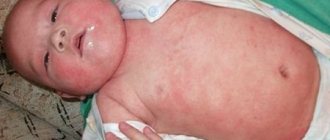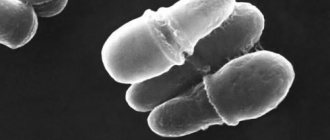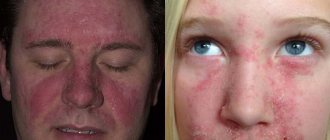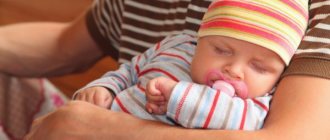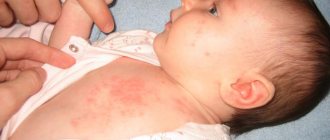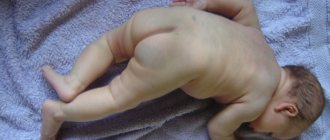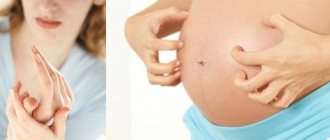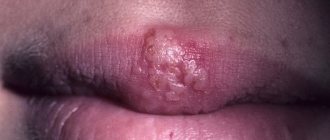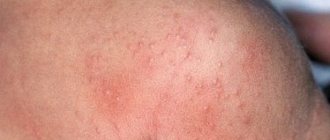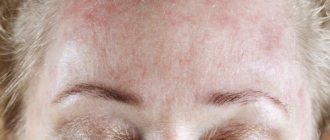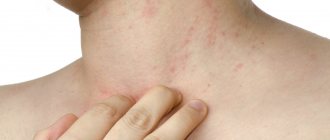The skin of newborn babies is very delicate and vulnerable to various types of inflammatory reactions. Seborrheic dermatitis in infants refers to inflammation of the skin. This pathology occurs as a result of intense and excessive production of sebaceous gland secretions. This disease is diagnosed in children under one year of age and is a normal variant. The child does not feel any discomfort, and the dermatitis often goes away on its own. There are situations when seborrhea becomes the cause of errors associated with the daily care of the baby.
Features of the disease
Seborrhea often occurs on the scalp. The disease begins to develop gradually. At the initial stage, the skin becomes covered with small pustules or pimples. Parents notice redness and increased sweating in the scalp.
The rash gradually acquires yellow crusts, which cause severe itching. In adult patients, this disease is almost never diagnosed. Crusts occur only in rare cases. Dermatitis develops after using incorrectly selected cosmetics, as well as as a result of the presence of a fungal disease.
Treatment of seborrheic dermatitis in infants is required immediately after symptoms are detected. This is because children face discomfort and itching. Medicines will help prevent further spread of the disease. Babies under one year old develop baby crusts in their hair. They are not the result of a serious illness.
They gradually go away on their own and do not require special treatment. Often the crusts appear repeatedly and are chronic. In this case, parents need to contact a pediatrician who will prescribe medications. They will help destroy bacteria and harmful fungi.
Symptoms of seborrheic dermatitis in infants
This disease begins with the formation of ordinary dandruff. Without treatment, dermatitis progresses: rashes appear on the affected areas that do not hurt or itch. Over time, yellow or brown crusts form in their place. If you try to tear them off, an area of normal skin without pathological changes (redness) will be revealed underneath.
Stages of development of seborrheic dermatitis:
- At the initial stage, red spots appear on the skin, which over time begin to peel off.
- At the next stage, crusts form.
- Without treatment, the child's condition may worsen. Lethargy, malaise, sleep disturbance and digestion appear.
Medications are prescribed only in the treatment of severe forms of seborrhea.
Common Causes
Seborrhea can appear not only on the head, but also on other parts of the body. Yellow-pink cracks cause itching, discomfort, and redness on the skin. Doctors recommend treating such areas with a special gel. It is strictly forbidden to tear off the crusts yourself, soak them in oil, or remove them.
Horny scales hide delicate skin, which is easily injured. The main cause of inflammatory processes in infants is the fungus Malassezia furfur, which develops well in a humid environment. Various new growths, crusts and rashes begin to appear on the body.
Seborrhea is often confused with atopic dermatitis, which is hereditary and cannot be treated with ointments and gels. We can highlight the main reasons for the appearance of crusts on the body and head of a child:
- hormonal imbalance;
- chronic infections;
- improper functioning of the gastrointestinal tract;
- dysbacteriosis, introduction of complementary foods ahead of schedule;
- long and uncontrolled use of medications;
- complications during pregnancy.
Treatment of seborrheic dermatitis in newborns should begin with consultation with a pediatrician. This pathology occurs in infants if parents do not take enough care of their skin and do not follow the basic rules. The cause of the pathology can be poor ecology and severe air pollution.
Treatment of seborrheic dermatitis in infants
If symptoms are detected, you must call your local pediatrician at home and receive a referral for examination to a dermatologist.
The doctor must differentiate seborrheic dermatitis from psoriasis and lichen at any stage of the disease. To do this, the horny scales are scraped off. The biological material obtained in this way is sent for microscopic analysis. To eliminate possible doubts, bacteriological culture of the extracted scales can be performed. It will allow identification of the causative agent of the disease. Recommendations for treatment are formulated after deciphering the results.
If the affected area is localized only on the scalp, treatment comes down to thoroughly washing the skin with special shampoos. Twenty minutes before water procedures, it is useful to apply baby oil to the baby’s head, into which the contents of one ampoule of liquid vitamin E have been mixed. If you don’t have baby oil on hand, you can replace it with Vaseline. After applying the product to your head, you must put on a cap. Then wash your hair and comb out the scabs with a special brush (these are sold in pharmacies). At the end of the water procedures, a drying cream should be applied to the treatment area. Antifungal drugs should be used if such treatment does not help.
If the affected area is localized on the body, doctors recommend using a shower gel foam while bathing, then applying Saforel or Topicrem gel to dry skin.
If the lesion is on the face, skin contact with water should be avoided. And to treat areas covered with scales, use “Tsindol” mash or antifungal ointment.
Sick infants are required to take the drug “Aevit” and use a cream that contains vitamin “A”. This treatment maintains the elasticity of the skin and stops the peeling process. Antibiotics may be included in the general therapeutic regimen, but only if a bacterial infection is added to the course of the disease.
Clinical manifestations
Seborrhea often affects the scalp. To make a diagnosis, doctors examine the scalp and observe the baby’s behavior. Dermatitis is accompanied by itchy skin, so children become more capricious, often cry, rub their heads on the pillow, and refuse to put on a hat.
If parents notice such behavior in a child, then they need to check the skin and hair. Characteristic clinical manifestations can be identified:
- the crusts are hard and have a yellow-pink tint;
- small red pimples appear on the skin that look like prickly heat;
- hyperemia of the affected skin, skin irritation;
- dandruff.
Seborrheic dermatitis in infants is often confused with food allergies. For consultation you need to consult a doctor. He will monitor the child’s condition, give advice and recommendations on proper therapy. Pediatricians often prescribe effective medications, ointments and gels.
Prevention
Since seborrheic dermatitis develops under conditions favorable for the spread of pathogenic microflora, it is important to disrupt these very conditions.
- You need to carefully monitor the course of taking medications, do not exceed the dosage and do not prescribe treatment without the advice of a doctor.
- When the first signs of illness appear, even if it is a slight increase in temperature or a simple runny nose, you should consult a doctor to prevent a decrease in immunity.
- The child should walk in the fresh air every day, even in winter (dressed for the weather).
- It is advisable to take a course of vitamins seasonally (as recommended by a doctor).
- Provide the child with proper personal hygiene.
- Buy clothes and underwear for your child only from natural fabrics.
- The child must have personal hygiene and care products (toothbrush, towel, slippers).
- Protect the child from hyperthermia and hypothermia (dress appropriately for the weather).
- Ensure healthy 8-hour sleep and adequate exercise.
- Monitor your child's diet.
Seborrheic dermatitis is a common childhood disease that is easier to prevent than to treat. It rarely leads to complications, but in the absence of timely, quality treatment it becomes chronic. Sometimes, in advanced cases, damage to the skin (weeping wounds, burst blisters) is accompanied by an infection, so self-medication and postponing a visit to the doctor are unacceptable.
How to remove crusts
Many parents resort to tearing off dry scabs from their child on their own. They cannot be touched, because unprotected skin is injured and an inflammatory process may occur. The pharmacy sells special products that are intended for crusts on the scalp of babies.
Doctors often prescribe Vaseline oil. It should be used only after visiting a doctor. If the crusts do not cause discomfort, they do not need to be removed. There are several proven ways to get rid of seborrheic dermatitis.
Special shampoos
Pharmacies sell various shampoos that have been developed to treat seborrheic dermatitis. They will help quickly soften dried crusts while taking a bath or evening swim. At the same time, delicate skin remains safe.
It is strictly forbidden to use cosmetics, shampoos and medications that are intended for adults. This is due to the fact that children have different hormonal levels, and the skin is sensitive to different components of the composition.
Combs for combing
This method was used several centuries ago. But when combing, you need to follow certain rules and caution. Mechanical impact can harm delicate skin and injure it.
You should choose combs only from natural and soft bristles. She will carefully remove the crusts without affecting the lower layer of the dermis underneath them. Before the procedure, it is recommended to moisturize the skin with nourishing cream or oil and wait 5-10 minutes. When combing, it is forbidden to rush. The procedure is repeated 2-4 times until all crusts are removed.
Oil selection
The oil can be used as an aid that effectively removes crusts. It should be applied to the entire surface of the head or only to the affected areas. The composition helps soften the scales, as well as their painless removal.
In order for the product to act quickly and effectively, it is necessary to additionally put a cotton cap on the baby. It helps prevent greasy stains from leaving on the pillow. After using the oil and combing out the crusts, you need to wash your hair with baby shampoo.
Practical advice
Treatment of seborrheic dermatitis without following specific recommendations may be futile. Therefore, doctors advise all mothers:
- Do not put bonnets or caps on your child at home. Wearing them can cause sweating, which provokes the proliferation of pathogenic microflora.
- Monitor the air temperature in the room where the baby is. It should not exceed 20 degrees.
- For bathing, use only those cosmetics that are intended for the care of a newborn baby. Doctors recommend using regular baby soap.
- Reconsider your approach to personal hygiene: change diapers more often and bathe your baby without soap with the addition of chamomile or string infusions.
If the child is breastfed, the mother is advised to reconsider her diet and avoid eating foods high in animal fat (butter, full-fat milk, yogurt, cottage cheese). All sweets and baked goods should be banned.
When bottle-feeding, it is useful for the baby to change the formula, choosing one that is marked “hypoallergenic.”
Pharmacy products
The pharmacy has many products for the treatment of seborrheic dermatitis in children. Doctors may prescribe the following medications:
- Nizoral. The composition contains an antifungal component - ketoconazole. It helps eliminate itching and flaking. The product is used for the treatment of seborrhea no more than twice a week for 30 days. As a preventative measure, it is recommended to use shampoo once a month. This product has no age restrictions. Analogues are Sebozol, Dermazol, Ionel.
- Skin Cap. The main potent component is zinc pyrithioneate. It has an antibacterial and antifungal effect. With regular use, the intensity of itching and flaking decreases. Additionally, repeated relapse and complications of infectious etiology are prevented. The drug is prescribed to children who are already 1 year old. The duration of therapy is 2 weeks. An analogue is Friederm Zinc.
- Cynovitis. The composition includes a complex of main components - zinc pyrithione, urea, dexpanthenol, climbazole. The action of the medicine is anti-inflammatory, antibacterial, antifungal. Additionally, the skin is moisturized and dead cells are exfoliated. With regular and correct use, regenerative processes in soft tissues are activated.
The drug Cynovit in the form of shampoo should be used for a month, twice a week. The drug is suitable for dry and oily seborrhea. The medicine is prescribed to children over 1 year of age.
ethnoscience
Together with antifungal shampoos and oil, you can use traditional medicine. They can only be used on the recommendation of the attending physician. Effective means:
- Sage-based decoction. You need to take a tablespoon of dry crushed herbs and pour a glass of boiling water. Boil the product for 20-30 minutes. The broth is strained, cooled and strained. They treat the skin every day.
- Oak bark decoction. You need to take 25 grams of raw materials, pour a glass of boiling water. This product should be simmered for 5 minutes in a water bath. Infuse the decoction for 4-5 hours. Before use, the product is filtered.
- An infusion based on the following herbs - chamomile, calendula, plantain. You need to mix all these ingredients in equal proportions. They are filled with 300 ml of boiling water. You need to infuse the decoction in a thermos for 4 hours. Before use, the product must be filtered.
Decoctions prepared from medicinal plants should be used every day. They treat inflamed areas. Before the procedure, you need to make sure that the small child does not have an allergic reaction.
Preventive actions
Seborrheic dermatitis in infants can not only be cured, but also prevent the appearance of crusts on the head. There are several specific rules:
- compliance with all recommendations for caring for the child;
- hygiene monitoring;
- It is prohibited to use products that contain fragrances to bathe your baby;
- It is recommended to buy only hypoallergenic shampoos, gels and moisturizers at the pharmacy;
- It is forbidden to overheat the baby;
- ensuring optimal temperature in the room, level of humidity in the bedroom;
- timely introduction of complementary foods according to age.
Seborrhea in infants does not pose a risk to the health of an infant. If parents provide proper care for the baby, then such crusts will go away on their own. If the first signs occur, you should consult your doctor. He will give all the necessary recommendations and prescribe medications.
Reasons for development
In the first months, seborrhea in newborns refers to the physiological changes that the baby's skin may undergo. The so-called hormonal crisis leads to pathological functioning of the sebaceous glands, caused by an excess of female sex hormones in the blood of the baby, which he received in utero from the mother through the fetoplacental bloodstream. Physiological rashes disappear on their own after a few months.
If a secondary bacterial flora joins in or the rash is caused by a fungal flora, the elements of the rash continue to exist and develop further. The latter is realized thanks to the opportunistic flora of fungi of the genus Malassezia.
An infant may also have a pustular rash on the face (neonatal acne), in addition to seborrheic dermatitis.
